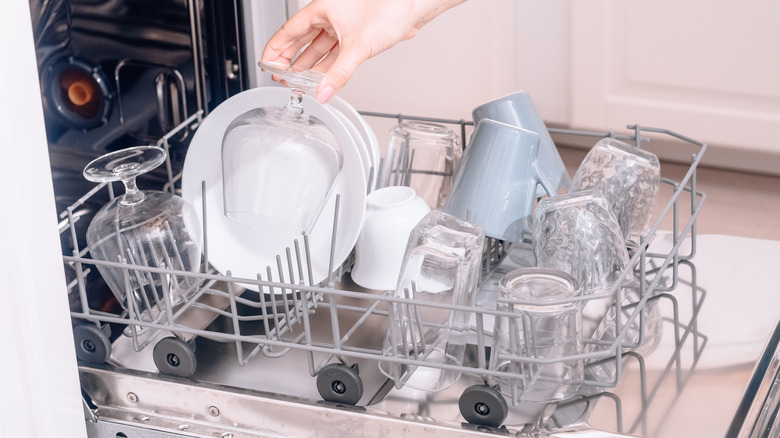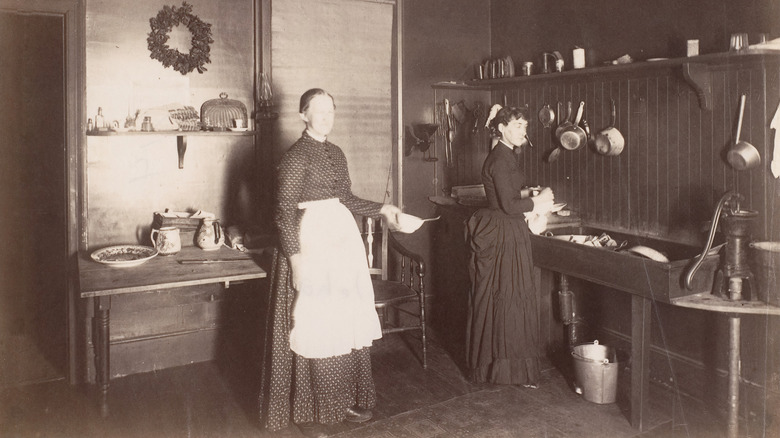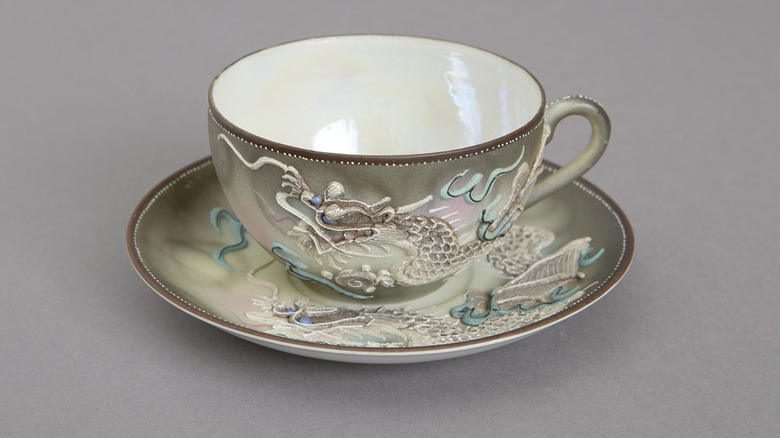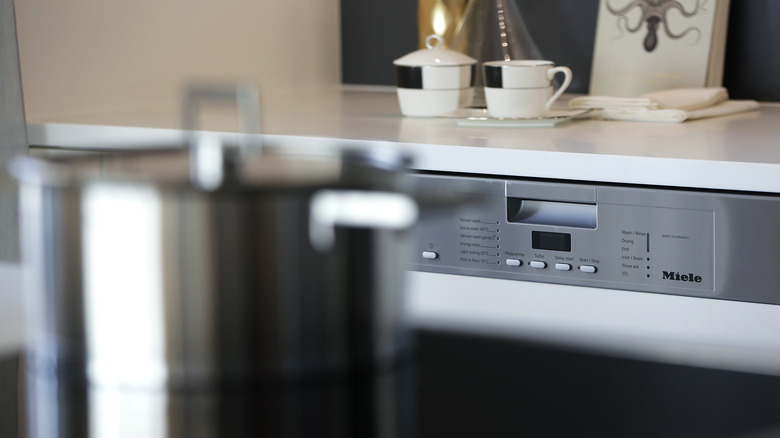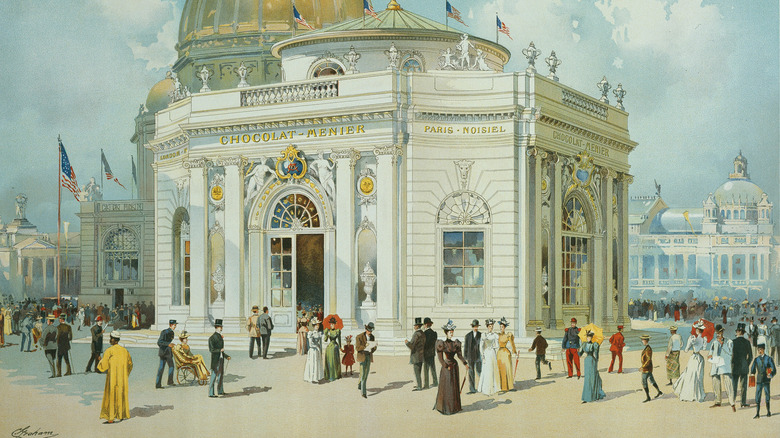Who Invented The Dishwasher?
Doing the dishes is, like doing the laundry, one of those household chores that can't be avoided —at least, not for long. And the longer you put it off, the bigger a job you have to tackle when you finally get to it. A century ago, the only way to wash the dishes was the old-fashioned way: dutifully hand-washing each dish individually. However, these days, 68 percent of American homes have a mechanical dishwasher (per WSPA), although it appears that a not-insignificant number of households with dishwashers — 20 percent of them — don't use them particularly often.
Inside the home, mechanical dishwashers are a convenience, but in places where a high volume of food is consumed each day — a hotel, for example, or a hospital or restaurant — these machines are absolute necessities. Indeed, it was via the hotel industry that mechanical dishwashers first became a thing, according to the National Inventors Hall of Fame. Josephine Cochrane wasn't the first person to entertain the idea of a machine that washes dishes, but earlier patents used hand cranks, while the Illinois socialite was the first to create one that uses a motor. Indeed, the company that bought her patent may have produced the machine that is in your own kitchen.
Early efforts
For centuries, the only way to wash the dishes was by hand, and indeed, that's the way about a third or more of American households still do them, according to WSPA. However, the dishwashing liquid that creates delightful foam and suds (and generally does a good job of getting rid of even the toughest food residue) wasn't invented until the 1950s, according to Packaging News. Prior to that, you used soap — like the kind you bathed with — and elbow grease. It was a painstaking, tedious process that was, by and large, pawned off on women, or on servants — especially female servants.
At least two inventors filed patents for dishwashing machines, but neither of them went anywhere. All the way back in 1850, according to ThoughtCo, a man named Joel Houghton came up with the idea of a machine that splashed water on dishes via a hand-turned crank. A decade later, L. A. Alexander patented a machine that spun dishes through a tub of hot water. Neither machine was particularly effective.
First world problems
Josephine Garis, who later went by Josephine Cochrane (or sometimes Cochran, according to the U.S. Patent and Trademark Office), was born in Ohio in 1839. Her father was a civil engineer and her great-grandfather was an inventor, but she had no formal scientific education herself. Instead, she was married right out of school at the age of 19 to a well-to-do dry goods merchant, and soon found herself hosting dinner parties among the well-heeled of Shelbyville, Illinois. However, she noticed that her fine china, which by some accounts dated to the 1600s, would often get chipped while her servants washed the pieces. Distraught, she tried washing it herself but quickly learned how thankless a task it was. According to legend, the frustrated socialite shouted, "If nobody else is going to invent a dishwashing machine, I'll do it myself," and sketched a design for a prototype.
As the old saying goes, necessity is the mother of invention, but in Josephine's case, looming penury helped push things along. Her husband died, leaving the socialite in debt, and in order to come up with some money, she hired an engineer named George Butters, and together they produced a working machine in a shed behind the widow's house. In 1886, she received her patent. Her device, unlike others, held the dishes on racks, used a motor rather than a hand crank, and sprayed pressurized, hot water over the dishes.
More first world problems
Having an invention is one thing, but convincing people to buy it is another. Josephine Cochrane knew that dishwashers for the home would be a hard sell for a variety of reasons (many of which will be explained later). So instead, she focused on places where washing a high volume of dishes in a short amount of time was a necessity: hotels. Unfortunately for Cochrane, this was the 1880s and for a woman to go into a hotel unaccompanied was downright scandalous, and a woman being there conducting her own business was downright unheard of. "You cannot imagine what it was like in those days ... for a woman to cross a hotel lobby alone," she told a reporter at the time, per A Mighty Girl. "I had never been anywhere without my husband or father — the lobby seemed a mile wide. I thought I should faint at every step."
Nevertheless, she persisted, and for her efforts, she was able to sell her machine. "I got an $800 order as my reward," she said of one sale — an impressive amount of money in those days (especially considering that a modern, home-kitchen dishwasher costs about half that).
The Chicago columbian exposition changes everything
Though his accomplishments are now discussed through the lens of modern attitudes, there was a time when explorer Christopher Columbus was celebrated without question. Such was the case in Chicago in 1893 when the Columbian Exposition (pictured above) celebrated the 400th anniversary of the explorer's arrival in the New World (albeit a year late). Among other things, the world's fair was intended to showcase new and emerging technologies — and the dishwasher was such a technology.
According to A Mighty Girl, Josephine Cochrane's machine, already in use in some hotels, was exhibited at the exposition to rave reviews. While Cochrane's dishwasher did win the top award for "best mechanical construction, durability, and adaptation to its line of work" at the World's Columbian Exposition of 1893 in Chicago, according to the United States Patent and Trademark Office, it did not immediately make its way into U.S. homes. The average consumer didn't embrace the dishwasher until the 1950s, according to ThoughtCo. What's more, she found her company, Garis-Cochran Manufacturing Company, getting more orders from hotels across Illinois and the Midwest. Further still, it wasn't just hotels purchasing her machine: According to the United States Patent & Trade Office, hospitals and colleges, which moved large volumes of food and (in the case of hospitals) had to adhere to stringent sanitation requirements, also began ordering her machine.
In 1916, three years after her death, the KitchenAid company purchased the Garis-Cochran Manufacturing Company, and indeed, it's not unlikely that the dishwasher in your home bears the KitchenAid name.
Home dishwashers took several more decades
Josephine Cochrane's invention, though born out of frustrations with washing dishes in her own home, was always intended for places that moved high volumes of food, such as hotels, hospitals, and colleges. It would be several decades after their invention that the average American home was even able to accommodate one, according to IEEE Spectrum. One problem was that, until the 1950s, most homes' hot water heaters couldn't keep up with demand that dishwashers put on plumbing. Another problem was the kitchens themselves: most weren't built to accommodate the machines, and it wouldn't be until the 1960s that kitchen designers started designing spaces to include them (via Home Stratosphere). Finally, there was the cost — though the post-war economic boom of the 1950s helped, the machines were still, at the time at least, only available to the wealthy.
By the 1970s, technology had driven the size and price of the machines down, Americans had enough money that they could afford them, and kitchens (and plumbing systems) were able to accommodate them. It was in that decade that they started becoming more or less ubiquitous in American homes, and these days, only about one in three are without them. These days, Cochrane's legacy is secured. Every time you load up your dishwasher, you can thank this female inventor's cracked china.
